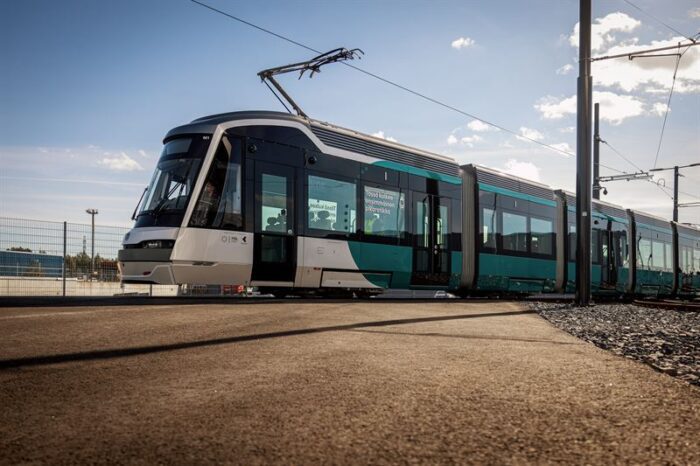Emissions-free transport milestone: Helsinki jubilantly opens new 25-kilometre light rail line

Photographer: Helsinki City Transport
A new light rail line serving the Helsinki metropolitan area was taken into use amid much fanfare on Saturday, 21 October. Running crosstown between Espoo’s Keilaniemi and Helsinki’s Itäkeskus districts, the new light rail line is a substantial investment in zero-emissions public transport. It also brings the City of Helsinki one step closer to achieving its goal of carbon neutrality by the year 2030.
A new light rail line serving the Helsinki metropolitan area was taken into use on Saturday, 21 October 2023.
Finland’s capital region was happy to celebrate the launch of its new light rail route almost one year ahead of schedule. Originally slated for completion in summer 2024, the light rail line project that started in 2019 was instead handed over to the metropolitan cities of Helsinki and Espoo and the public transport company Metropolitan Area Transport Ltd already in late August 2023. Because construction was completed ahead of schedule, regular traffic on the line also started earlier than had been expected. This efficiency can in part be attributed to what has since been identified as a key success factor of the project: the alliance model, whereby the customer, designers and contractor are combined into one joint organisation.
The opening of the new line is historic for another reason as well. Over the last 120 years, Helsinki has built up a 50-kilometre tram network that has become well-established. In the last few decades, the network has seen only minor changes but this all changes in autumn 2023, when the 25-kilometre route increase introduced by the new light rail line will single-handedly expand the tramway network by about 50 per cent.
Comprehensive rail network as a city planning goal
The new light rail line has also led to significant levels of new housing being built up near the route in Helsinki and Espoo. Paths for cycling and pedestrians in the vicinity have also been renewed, and the light rail stops have been situated with not only current but also future housing, jobs and services in mind.
“Helsinki’s goal is to develop into a rail traffic network city. Already during the construction phase, the new light rail line has accelerated urban development. The numerous building projects that have sprouted up alongside the route show that the residents and the business community find proximity to the light rail very appealing,” said Ville Lehmuskoski, Executive Director of the City of Helsinki’s Urban Environment Division.
The light rail line replaces the busiest bus line in Helsinki, which would not have been able to handle the increased passenger flow projected for the coming years. The new light rail line can convey triple the number of passengers, which is quite a feat when one considers that the current bus line already transports up to 40,000 passengers on most weekdays. In 2030, this number is expected to grow to 91,000 passengers a day, and in 2050 it may be as many as 125,000.
The capital area cityscape has changed appreciably because of the new light rail line. Eleven new bridges have been built and several more have been repaired, with three of these widened. In addition, the project required excavation of a concrete and rock tunnel 300 metres long in Helsinki’s Patterinmäki neighbourhood and the construction of a new tram depot in Helsinki’s Roihupelto district.
Light rail is a climate act
Helsinki is committed to promoting sustainable transport that is good for the planet. Expanding rail traffic is one of the most effective ways to reduce traffic emissions. Light rail is a climate act in and of itself, but its significance is increased by the excellent interchange connections from the light rail line’s stops to the region’s many railway, metro and bus lines. Planners have also made sure to provide ample bicycle parking and accessible pedestrian routes in association with the new service.
“About a fifth of Helsinki’s climate emissions are caused by traffic. In order to achieve our ambitious climate goals, it is very important that the City of Helsinki invests in emissions-free rail transport. The opening of the new light rail line is a truly momentous occasion for the entire Helsinki region,” said Anni Sinnemäki, Helsinki’s Deputy Mayor for Urban Environment.
Light rail runs on electricity produced with wind and hydropower, both sources of renewable energy. The carriages are designed to be energy-efficient, for example, braking energy is recovered and used for air conditioning in the summer and heating in the winter.
More rail transport projects in the pipeline
Rail transport will play an increasingly significant role in Helsinki and Finland’s entire metropolitan area in the future. Rail traffic is already expanding at an historic rate. In addition to the launch of the city’s first light rail line, several other rail transport projects are currently being planned or built.
Construction is underway in Helsinki on a new 4.5-kilometre tramway to connect the new Kalasatama district with the hub of Pasila. Operation of this new tramway is scheduled to begin in 2024. The Crown Bridges light rail project is also under construction, featuring a 10-kilometre light rail route that will connect the island of Laajasalo with the Helsinki city centre. Among other things, the Crown Bridges project includes construction of a 1,200-metre-long Kruunuvuorensilta bridge, which when completed, will be the longest bridge in Finland.


